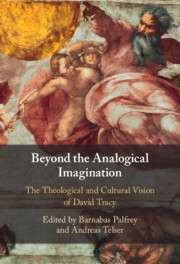Book contents
- Beyond the Analogical Imagination
- Reviews
- Beyond the Analogical Imagination
- Copyright page
- Epigraph
- Contents
- Contributors
- Acknowledgements
- Introduction
- Part I Theology and Culture
- Chapter 1 David Tracy’s Theology-in-Culture
- Chapter 2 Analogical Imagination and Ana-theological Believing
- Chapter 3 Closed Totality, Collage, and the Fragmentary Between
- Part II Public and Beyond
- Part III Church and World
- Part IV From David Tracy
- Part V Post-Script
- Bibliography
- Index
Chapter 3 - Closed Totality, Collage, and the Fragmentary Between
from Part I - Theology and Culture
Published online by Cambridge University Press: 28 September 2023
- Beyond the Analogical Imagination
- Reviews
- Beyond the Analogical Imagination
- Copyright page
- Epigraph
- Contents
- Contributors
- Acknowledgements
- Introduction
- Part I Theology and Culture
- Chapter 1 David Tracy’s Theology-in-Culture
- Chapter 2 Analogical Imagination and Ana-theological Believing
- Chapter 3 Closed Totality, Collage, and the Fragmentary Between
- Part II Public and Beyond
- Part III Church and World
- Part IV From David Tracy
- Part V Post-Script
- Bibliography
- Index
Summary
This essay begins with a close reading of Tracy’s recent programmatic formulations concerning: (1) the ‘strong fragments’ of culture that ‘shatter, fragment, negate any closed totality system’; and (2) those ‘most powerful fragments’ that ‘show themselves not as substances but as events and positively open to liminal Infinity’. If some cultural fragments are mere ‘period pieces’ without enduring truth or transformative power, and others are dangerously nostalgic, these fragments, Chase suggests, can act strongly when collaged into some ‘new form of witness against any false whole or claim to completeness’. T. S Eliot’s The Waste Land is an ambiguous example here. The pinnacle of the fragment for Tracy, however, is the ‘frag-event’ that opens towards the creative liminality of an invisible Infinity. ‘Marxist-Kabbalist’ Walter Benjamin is ‘the projective force’ behind Tracy’s forays into the fragment. The essay proposes the role of assemblage or collage for both fragmenting fragments and the Tracyean frag-event, stressing the role of edges and unexpected connections, and concluding by wondering how far Christian theology is really ready to think in such a manner of collage.
Keywords
- Type
- Chapter
- Information
- Beyond the Analogical ImaginationThe Theological and Cultural Vision of David Tracy, pp. 65 - 84Publisher: Cambridge University PressPrint publication year: 2023

